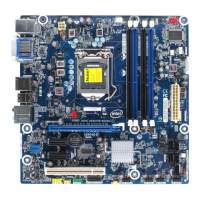Installing and Replacing Desktop Board Components
47
S/PDIF Header
Figure 22, C shows the location of the S/PDIF output header. Table 10 shows the pin
assignments and signal names for the S/PDIF output header.
Table 10. S/PDIF Header Signal Names
Pin Description
1 Ground
2 S/PDIF Out
3 Key (no pin)
4 +5 VDC
Serial Header
Figure 22, D shows the location of the serial header. Table 11 shows the pin
assignments and signal names for the serial header.
Table 11. Serial Port Header
Pin Signal Name Pin Signal Name
1 DCD (Data Carrier Detect) 2 RXD# (Receive Data)
3 TXD# (Transmit Data) 4 DTR (Data Terminal Ready)
5 Ground 6 DSR (Data Set Ready)
7 RTS (Request To Send) 8 CTS (Clear To Send)
9 RI (Ring Indicator) 10 Key (no pin)
Consumer IR (CIR) Headers
The Desktop Board has two CIR headers: the receiver or input header (Figure 22, F)
and the output or emitter header (Figure 22, E). The receiver header consists of a
filtered t
ranslated infrared input compliant with Microsoft CIR specifications and a
“learning” infrared input. The learning input is a high-pass input which the computer
can use to “learn” to speak the infrared communication language of other user
remotes. The emitter header consists of two output ports which the computer can use
to emulate “learned” infrared commands in order to control external electronic
hardware.
NOTE
The Consumer IR option must be enabled in the system BIOS before it can
function. Press <F2> at boot to enter the system BIOS, and go to Advanced >
Peripheral Configuration > Enhanced Consumer IR, and set this option to
Enabled.

